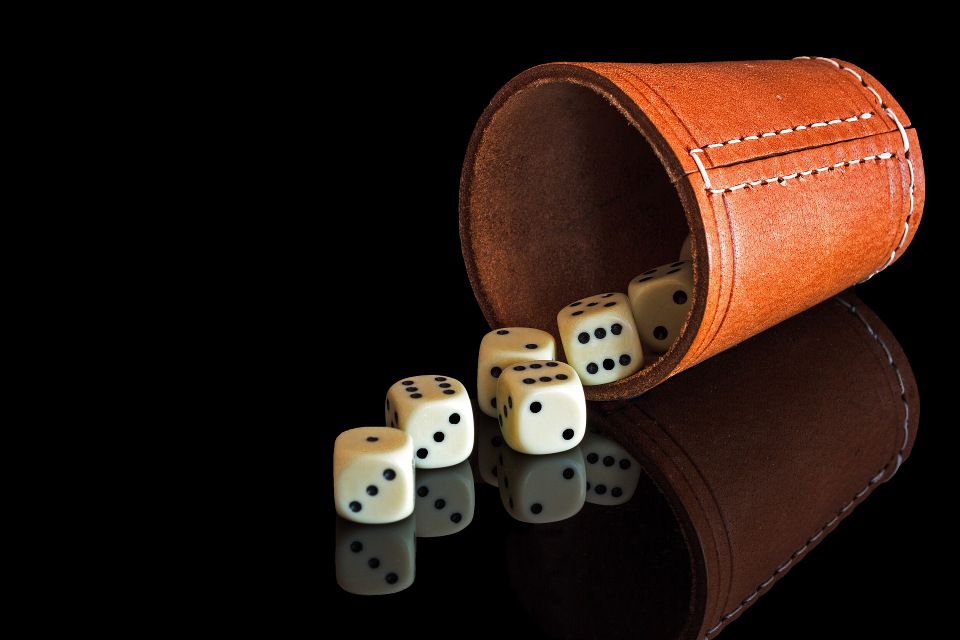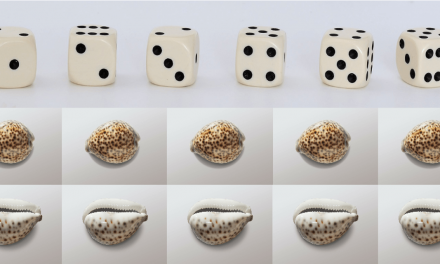In Part 2 of this series, we presented :
How Plato Influenced Modern Role Playing Games
– – –
In this post, we’ll explore the basic notions of how dice work and why you shouldn’t worry if you just don’t get the math. In short, it’s okay. The math is built in. So, you don’t have to worry about it.
And we’re confident enough about that point to offer you a choice.
If you want to skip the math, CLICK HERE
But, if you just want to know. If you want to peek under the hood and see what it’s all about. We’ll be explaining how game mechanics – especially dice mechanics – function as any game’s “game engine”. Right here. In this post.
So, if you don’t mind getting your hands dirty, just keep reading …
The “Show Me The Math” Blog Post
All you need to know in order to understand how dice work is this:
1. Dice are made in such a way as to be balanced. That is, every side (or facet) of a die has just the same chance of coming up as every other side has.
- This sort of outcome is known as a linear or “straight line” result. (Because a graph of the input and output of a 1-die system is in fact a straight line.)
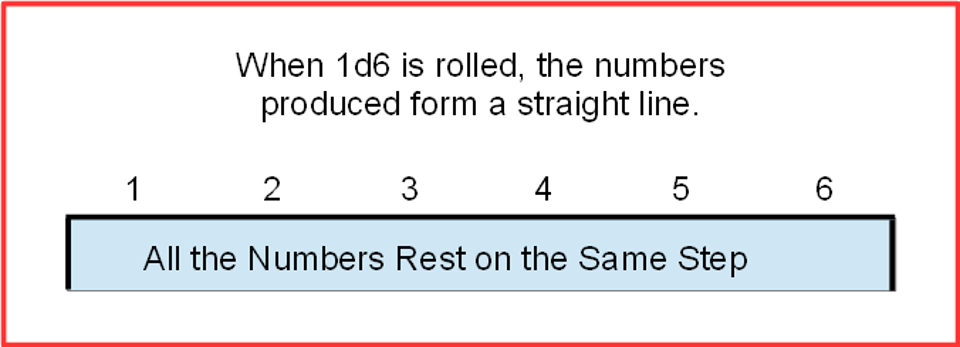
2. Chance is measured in percentages and also in odds.
- Like this “10% of the time” (like a chance of rain)
- Or like this “1 chance in 10” (a little old fashioned)
- Or like this “ 9:1 ” (which only seems more complicated)
- This is “nine to one” or “nine chances to lose and just 1 chance to win (out of every 10 tries).”
- This is known as “odds against” and is the most common way to express odds.
- Using this system, the bigger number is always losses and the smaller number (usually set at 1) is wins (out of the combined total).
3. These percentages and odds are dependent on the type of dice that are used. That is, how many sides or facets they have. And, the more facets any die has, the lower the chance for any particular facet to come up when the die is rolled.
- For example, a six-sided die has 1/6 chance (16.67%) of any particular facet coming up when rolled. And a ten-sided die has 1/10 chance (10%) of any particular facet coming up when it is rolled. And a 20-sided die has only 1/20 chance (5%) of any particular one of its facets coming up when it is rolled.
4. The most common dice have 6 sides. And gamers call these “d6’s” because of their number of sides.
- So get used to adding and subtracting, multiplying and dividing by 6. You’ll be doing a lot of it.
5. When two six-sided dice are rolled together (2d6), the results are no longer linear. Some of the numbers (that is, the added results) come up more frequently than others. But here’s the good news : it’s predictable. So, you will know what to expect. And if you just can’t remember – or don’t really want to do the math – here’s a cheat sheet that you can download: Dice Tables.
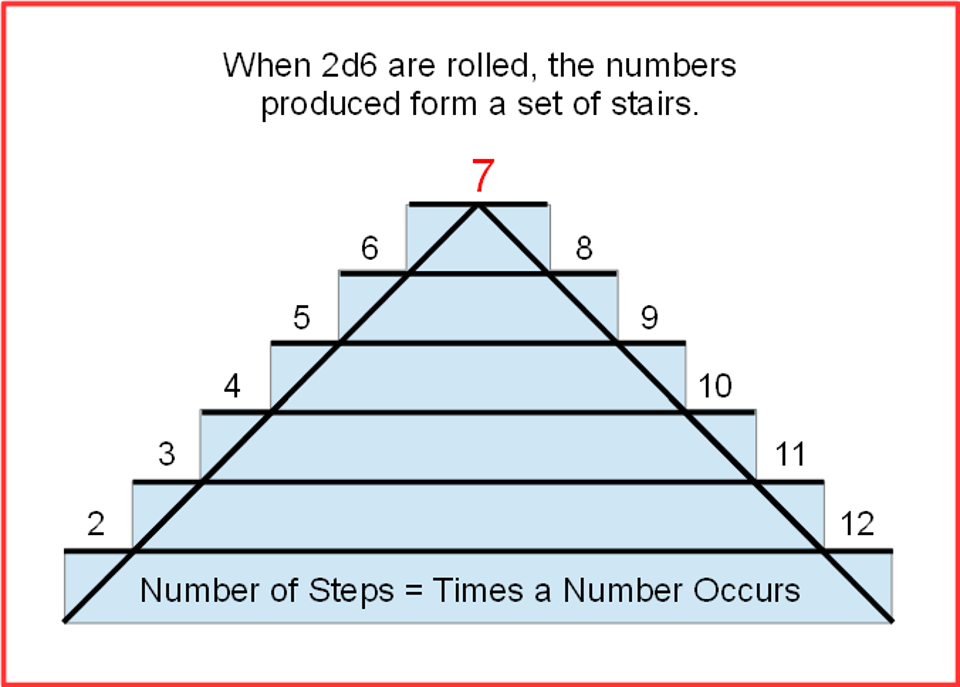
6. And finally, the next illustration shows the kind of graph that is produced when many dice are rolled at once. The bell-shaped red line in the drawing is known as a “normal distribution” or “binomial distribution” curve. Which, in the end, only means that the group of dice you cast in a game (and in some games that can be a whole lot of dice at once) really can simulate real-world occurrences. Or at least the frequency of those occurrences.
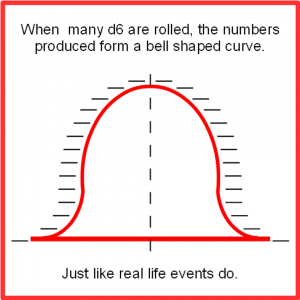
So, you might ask, what does this have to do with game engines? And what does any of this have to do with me?
Just this:
Presumably, you are a game designer or someone that is interested in how games work. How they function. And you may even have a game you’ve been working on or one that, someday, you’d like to make a prototype of.
But you’d like to know some more about dice before you do.
So, here you go. My take on dice mechanics. Their purpose and how you can best use them.
Ready?
If an event can be simulated, or the “aura” or “feeling” of an event can be captured in a game in the first place, then, with careful planning and lots and lots of playtesting, some number and configuration of dice – a dice mechanic – can likely be devised (or adopted and adapted) and then used to evince that feeling in others and project that aura for future game players to enjoy while they play your game.
And there you have it. Short and sweet. Simple. Easy as pie.
Dice have been around for nearly forever and they aren’t going anyplace any time soon. So, why not use them in one of your games. The math will take care of itself. Just sit down and cast away. You’ll do great! And your game will sell like hotcakes!!!
That’s it for now … (must be hungry … how many references to food is that?) … see you next post. 🙂
Part 2: The “No Math” Blog Post
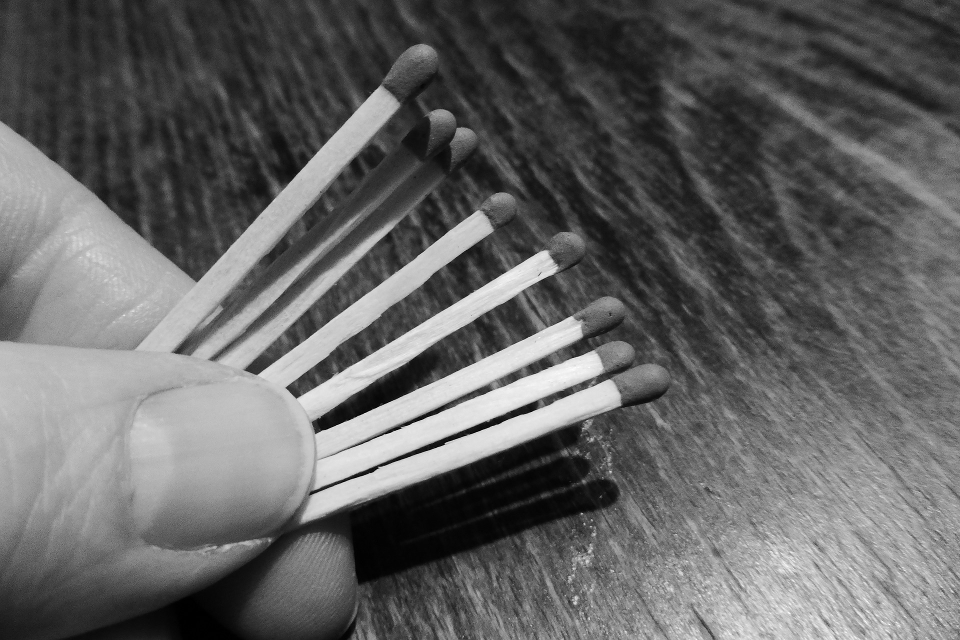
In the above picture, matches are being offered for selection. And everybody picks one. But one is shorter than all the rest. Have you ever done this? Maybe to assign gifts or even chores?
Well, when I was young, we did something a little different. But not much.
My mother would sometimes have us children draw straws instead. And it was usually to settle some argument or to set out some fair way to share either the work or the rewards of life on our farm.
Not that we couldn’t have come to some agreement among ourselves and not that there was really anything to complain about in the first place. But we did complain sometimes – or at least grumble – when the days seemed long and the work on the farm seemed about to last forever.
It was in times like that that my mother would consult her corn broom for a loose straw, get out the cast iron kitchen shears, and make up a set of draw straws – one for each child and one a little shorter than the rest.
Then we’d line up, none of us wanting to be first or last since there was a rumor that that’s where the work settled most often. On the first one that drew a straw or on the last one.
My next youngest brother, though, had a different opinion all together. He always said it wasn’t the order of who drew the straws that mattered, but rather, the position in the hand that held them that made all the difference. And I think he may have been right.
Mom would tend to tease and ask, “Are you sure that’s the one you want?” Or say, “You know, that one right there is the one that comes with extra chores.” And sometimes she’d seem to squeeze her hand shut tighter on some of the straws than on the others. But that may just be a child’s impression of how the jobs fell out – big lots of ’em on me, and even more for my brother and I to share between us.
What I didn’t know in those days was that randomness only seemed to favor this one or that one and that, in and of itself, none of those draw straws ever had it in for me or for anyone else. They simply supplied an unbiased choice – most of the time.
The same is true of dice. The kind we all played with as children and the kind that can be found in nearly every household in America. And in lots of other places besides.
Have you ever played Monopoly? It uses dice. Or what about Yahtzee? Ditto, it also uses dice. Boggle? You get the idea. They all use dice.
And let’s see: There’s Chutes and Ladders, Ludo, and Candy Land. Not to mention Dungeons and Dragons and some of the other Role Playing Games we touched on in our last post.
In fact, there are more games that are played with dice, or that at least are sometimes played with dice, than a person could comfortably list in a composition sized notebook. If you doubt this point, just fire up your favorite browser, drill down past the sponsored ads, and make a note of all the games out there that use dice.
Just take your notebook (about 100 pages at 20 to 25 lines per page per side) and see if you can’t list … what’s that come to? About 4000 or 5000 games. Piece of Cake. You’d probably have writer’s cramp by the time you got them all down.
And in none of those games are the dice out to get us! Nor are they poised to bring us riches, in game points, that is. Nor in any other way. Dice are truly unbiased. In part, because they don’t have a Mom to influence the outcome. 🙂
Dice have no memory of who casts them or of how they are cast. They haven’t a care in the world. And they don’t know any of us from Adam. So, how or why could a pair of dice ever slant a game in our favor or slant one against us?
They, in fact, do not. They can not. They simply carry on. And do their jobs the way they were intended to do them. And provide random choices whenever random choices are needed.
And that’s only sometimes during a game.
– – –
I changed my mind, Show Me The Math
– – –
In our next post …
Dice and The Law – Regional Opinions That Have Varied Over Time
Have you ever heard the expression, “No dice”? Most of us have. But do you know where the expression comes from? Urban legend or not, here’s the scoop.
